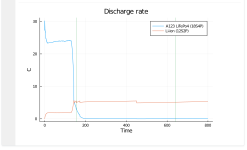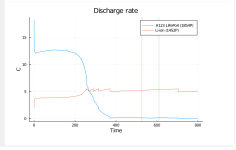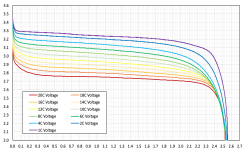I've been flying RC for over 30 years and exclusively electric jets for 20 plus years. Three and a half years ago I converted my mountain bike to electric and used a bunch of 5800 mah Hobbyking/Turnigy lipos in 3 x 4S and then 4 x 4S packs. They were older and were given to me and I puffed some of them and others had no issues. The small capacity was frustrating, I burned about 500mah per mile on average so 10 to 12 miles was all the range I got. I started using them in parallel but charging up 8 packs on model airplane lipo chargers was a pain. I used low voltage alarms on each pack that would start going off with an audible beep when voltages went below 3 volts per any particular cell. Sometimes I would hear and and keep going because well I was almost there. I puffed a few packs that way, but I knew each cell had the voltage being monitored.
After a couple of months I saw 16000 mah 4S packs on clearance at Hobbyking, so I ordered five of them and the larger capacity worked SOOOO much better. It was much easier charging packs with 3 times the capacity. Actually they were 8000mah cells paralleled together on the inside but I didn't know that until I pulled the insulation off of one to pull re-attach a broken balancer wire. Some of the cells would give about 12000 ish and then start dipping below 3 volts and set the alarm off. I'd make a note on the pack and favor others or just plan on not getting 16000 out of them. I was running at 15 to 30 amps, depending on the terrain, so 1 to 2 C, not pushing them hard. The were advertised as 10C packs and that was probably at best, and the 16000 milliamp/hour rating was best case. After those were bought, the 12C Turnigy 16000s came out but I never bought any, when it came time to buy them they'd go out of stock in the Spring. I don't know if they are paralleled or not.
I've just bought some 4S 16,000mah packs on ebay or Amazon under the TCB brand and after a few runs I've seen I can get 15,500mah out of them like I did last night, and no low voltage alarms (I re-set my alarms to 3.1 volts per cell to baby them a bit more, because once you're at 3 volts you might be already damaging them. I don't know if they're paralleled inside or not, but they're working great and 3 year newer tech and a few cycles seems to make a big difference. I don't recall the C rating but they can probably handle quite a bit.
My point is that bigger individual cells seem to make more sense than paralleled smaller capacities. I can monitor the voltage of each cell and if a cell goes bad and starts dropping below my set voltage, I'll get a beeping alarm (an boy are they loud and annoying).
If I was running 18650 packs (well I have a couple of new purpose built bikes with the normal 18650 type packs) and I had say a 13S (series) 4P (parallel) pack and I have a bad cell in one of the parallel rows, it may show a slight drop in voltage but say one cells is getting weak, the drop would only be a few percent, or maybe at most 25% with 1 out of 4 in that parallel row being zero. The BMS might see that and not let the pack work at all, but if the cells is losing capacity and draining early and getting hot, the BMS might not catch it and my worry worry is a fire could happen.
With bigger cells, it's easier to detect a bad cell via low voltage, puffing, or feeling the heat coming off of it. Repairing packs or replacing cells is easier.
As far as overall pack size goes, pushing cells hard leads to puffing/cell damage. I did a lot of that early on with RC jets where you tend to pull a lot of current in a 3 to 5 minute flight. The cells were 2000 mah back then, so we'd have 5S 4P packs to get 8000 mah, and the individual cells weren't happy sometimes. When the bigger 5000 mah cells came out they were a lot better, but still I've puffed some of those, in airplanes and in ebikes.
You might run the numbers and have a pack that theoretically will meet your needs, but the actual real-world numbers will likely be less than you expect. A larger pack that isn't run as hard will likely be a lot more reliable, and like others have said, having the power reserve to reduce land-out possibility would be nice and safer.
So going for a pack that's 8 times smaller is pushing it. Possibly 1/3rd the size would be a better option.
As far as portability, the battery can be made into modules that are hooked into parallel or series so you that don't have to lift super heavy packs. Charging inside the plane doesn't seem as safe, if the pack goes the plane might also. But if you can monitor each cell, I guess that might be alright.
When/if I build my bird, I'll more than likely go with big lipos...bigger cells are better to manage and monitor.
I'm not running a BMS system on them, but that would make charging easier, though slower ( I charge as fast as my little Astroflight 109 chargers will go, 8 or 10 amps, vs 18650 pack BMSs charge at 2 or 3 amps so I takes a few hours). Some BMSs have bluetooth so you can monitor individual cell voltages on your phone and that's very attractive and something I might do if/when I finally get started on my electric Part 103 ultralight design.




